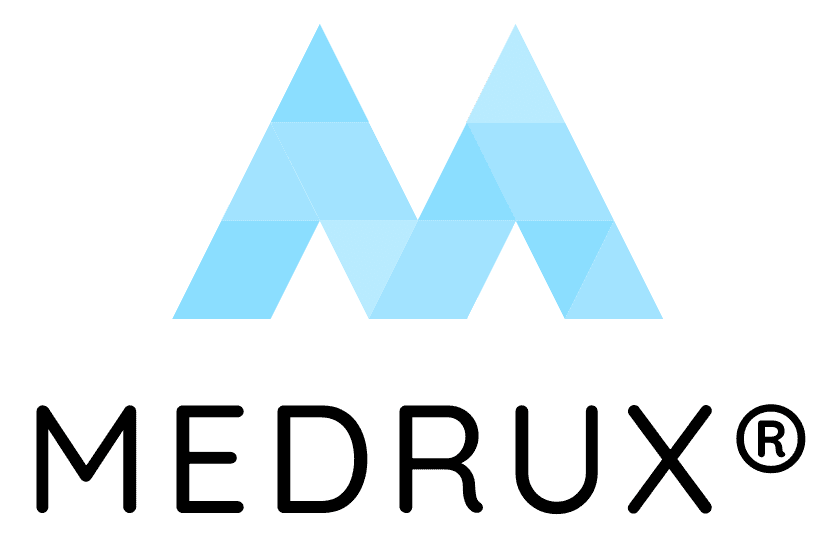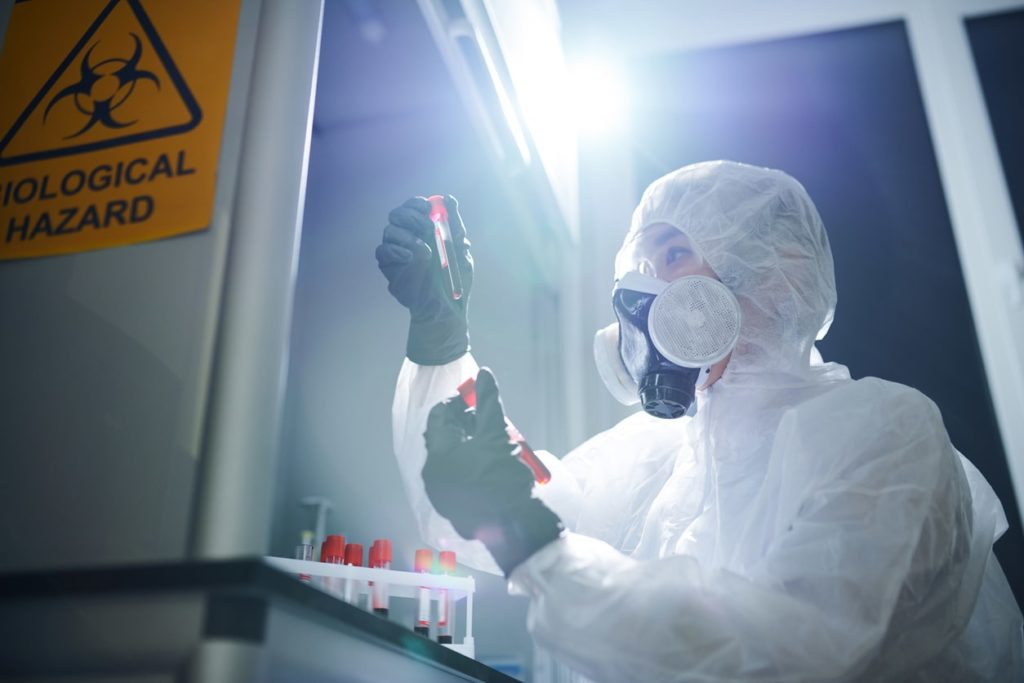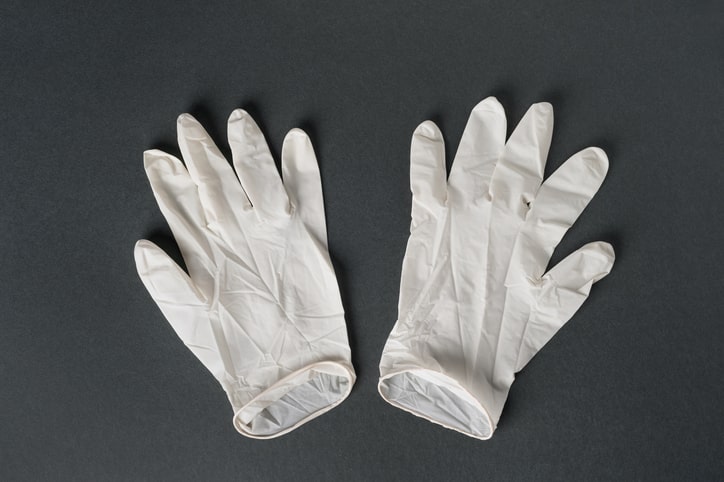Do you work in areas where you need to handle chemicals and other hazardous substances?
If you work in a hospital either as a doctor, nurse, or lab technician, you come in contact with a lot of harmful substances.
It is the same with people who work in the various industrial sectors, such as manufacturing, repairs, cleaning, etc.
Do you worry about your hands and skin? Are you wondering what the best way to protect your hands is? Hand protection in the form of gloves is necessary for people who work in such sectors. When it comes to gloves, the biggest categories are industrial and medical grade gloves.
Medical or Surgical grade gloves have to pass stringent tests and meet the safety requirements set by the FDA.
The gloves are tested for resistance to punctures and abrasions. They are put through tension and elongation tests to check for strength and against acids & chemical substances.
The FDA sets very strict guidelines and approves only if the gloves pass the tests. However, if the gloves do not pass the test, they are not ‘approved’ but still get ‘accepted.’
It means that the gloves are still of high quality and safe to use. They may not be good enough to be classified as medical grades, but they are still good enough to be industrial.
As industrial-grade gloves, they still have to meet high levels of resistance to punctures and chemicals.
The medical-grade gloves have a label that marks them as acceptable for medical and surgical applications.
Industrial-grade gloves do not have this certification. It is quite easy to differentiate between the two as the medical gloves have the word ‘Exam’ on the box, while industrial gloves do not.
Protecting hands and skin against chemicals
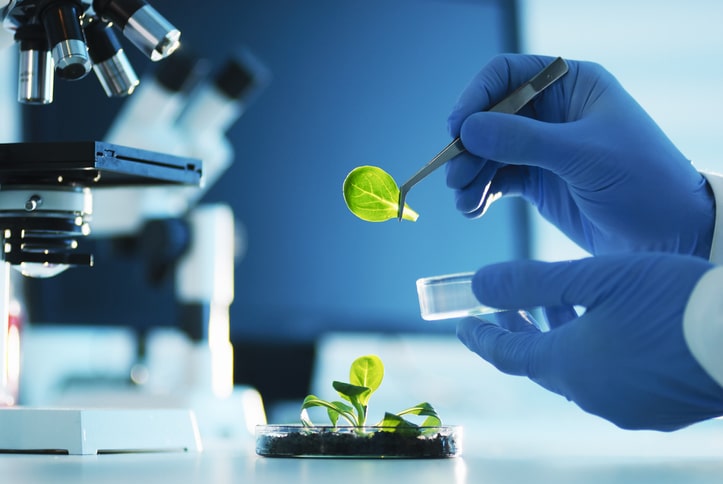
The most effective and reliable way to protect against harmful chemicals is to avoid contact with such substances.
Employers must take all steps to protect their employees, and the use of disposable chemical gloves will help achieve this.
It is important to remember that gloves differ in material, design, and thickness, and no single glove can protect against all substances.
When choosing protective gloves, you must pay attention to the following factors:
1- The type of work/ task
Gloves are used to protect hands and skin; they should not obstruct the task at hand.
For handling oily or wet objects, it is best to use rough textured gloves. You will get a better grip. Ideal gloves must balance dexterity and protection.
2- The environment of work
The work environment is also important. Do you work in a dirty, oily, factory or in a clean sterile lab?
Choosing a protective glove will also depend on how and where you are going to use it.
3- The substances to be handled
- Wet work, such as prolonged contact water with water along with detergents, can cause dermatitis. The best gloves for this kind of work are the ones that meet the European Standard EN 374-2. This certification means the gloves are waterproof.
- To protect hands from substances in a product or substances created by the work process, EN 374-3 gloves are ideal. However, depending on the substance, you must ensure that the material of the glove is suitable.
- Glove manufacturers give information about how well their gloves perform against various substances. They use 3 terms:
- Breakthrough time: it is time a chemical takes to reach inside through the glove. The term permeation means that a substance can pass through a material without pores, pinholes, or other visible openings.
- Permeation rate: this tells you the quantity of the substance which can permeate through the glove. It would be best if you looked for a low permeability rate.
- Degradation: contact with certain chemicals can damage the gloves and make them harder, softer, or change their shape. A good degradation rating is important for the gloves to protect better.
4- Any other hazards
When choosing gloves, apart from the acids, you must also identify all types of hazards present in the work environment.
If there is a risk of cuts or abrasions, you may choose EN 388 gloves, which protect you from chemical and mechanical hazards.
Or, if there is a high temperature where you work, EN 407 gloves may offer better protection.
5- Consider the duration and type of contact
This is extremely important while choosing the right gloves.
Will the user wear the gloves for short periods or more extended periods?
Comfort is a priority for long durations. The type of contact is also crucial because occasional chemical splashes are different from immersing hands in chemicals.
Short gloves are alright for splashes, but you will need longer gloves for better protection for immersion.
6- User’s size and comfort
Gloves should properly fit the user. One size does not fit all.
If the gloves are too small, they can constrain the fingers and cause pain. Too large, and the gloves can become unwieldy. Both ways, it is uncomfortable and can impair work.
Employees are more likely to wear comfortable gloves, and it is a good idea to involve them in the selection process. Hands get sweaty inside gloves, and it is essential to give the staff glove breaks.
Once the selection is made, employers must guide the employees to wear & use the gloves properly for proper protection.
How to optimize glove protection for industrial & medical uses?
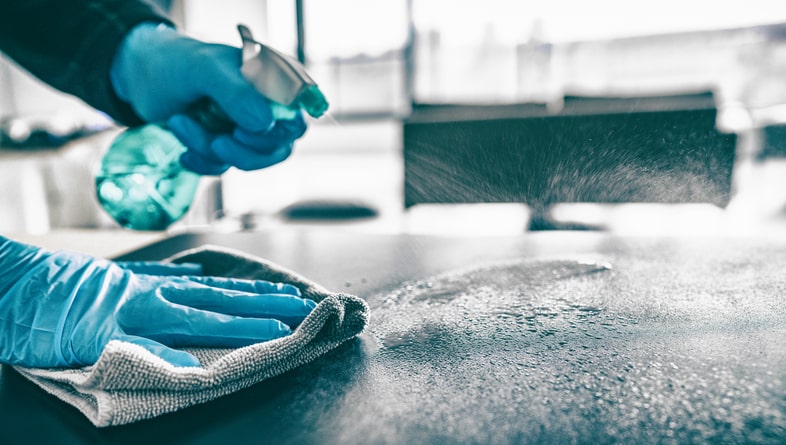
Both medical and industrial tasks require special care and handling.
There are acids and other harmful substances which workers may come in contact with.
Apart from choosing the most suitable gloves and wearing them while handling these substances, it is also important to ensure that you are using the gloves correctly.
- Remove the gloves carefully. This is important to avoid contact with the outside of the glove. This is crucial to prevent cross-contamination and protect the wearers themselves. Some good videos are also available regarding this, and employees can be shown these to explain the process better.
- Soiled or used gloves can contaminate surfaces or objects quite easily and expose the wearer and others to certain hazards. You can reduce the chances of this happening by:
- Changing contaminated gloves immediately after each task of chemical handling.
- Discarding the gloves immediately after use in an appropriate manner. Never reuse gloves after handling chemicals.
- Removing the gloves and thoroughly washing hands after the task is complete and before leaving the lab or workplace.
- Having clarity about objects which can and cannot be touched with or without gloves. These can include pens, keys, drawers, money, keyboards, equipment, door handles, fridge, etc.
- Not wearing the gloves out of the designated space, such as hallways, break rooms, elevators, restrooms, and other public areas.
- After repeated exposure, even the best gloves can break down. Before every use, you must inspect for any signs of degradation, cracking, shrinking, etc. All these point towards a physical change, which means that the gloves can no longer provide the same level of protection. While inspecting the gloves, look for any punctures or holes and if you find any, immediately discard them.
Which material is the best for industrial and medical gloves?
Different glove materials can resist different types of chemicals so that no single glove can protect against all types of chemical exposure.
A glove that is perfect for one kind of condition may be completely useless in another condition. The best thing to do would be to make the material selection based on the manufacturer’s guide.
Choose a material for the gloves that are most resistant to the acids you will be working with. However, it is essential to remember that actual resistance to a chemical may vary from what the manufacturer claims.
Nitrile Material (100% NBR)
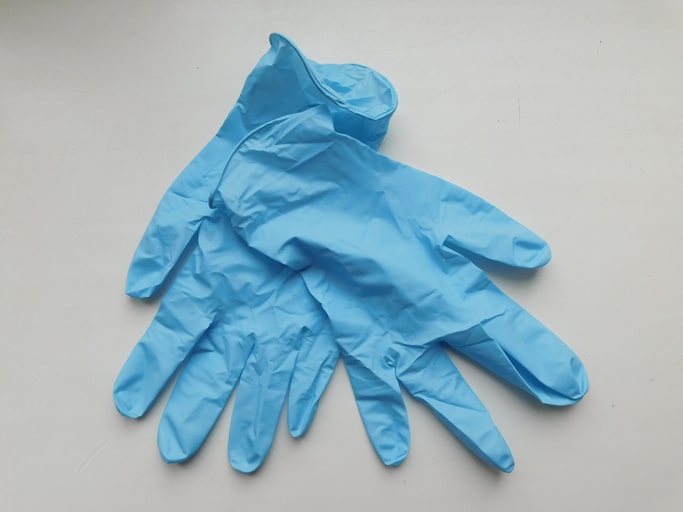
Nitrile is a synthetic material with properties like latex but no natural rubber in it.
Nitrile was initially designed to work as a replacement for natural rubber latex because of the concerns with latex allergies.
Now, Nitrile gloves are manufactured thinner and stronger than even the original latex gloves.
They give excellent protection and a better feel. Nitrile also offers excellent protection against acids, oils, solvents, bases, grease, and several other chemicals.
The nitrile gloves are durable and resistant to punctures, cuts, and abrasions. They are pretty common in all types of industries and have become a staple.
Latex Material (100% Natural Rubber)
This is the best-known material as far as gloves are concerned.
Latex gloves provide reasonable protection against acetones, thinners, and ketones.
They are durable, strong, bio-degradable and flexible. They are ideal for a variety of jobs.
The only problem with these gloves is that some people are allergic to latex, and any contact with the material can cause severe reactions.
Now, some latex gloves have reduced latex protein. This is the substance that causes the reactions. The additional processing helps in the reduction of latex protein.
Neoprene / Butyl

These gloves are made of synthetic rubber and are high density.
The wearer will experience good finger dexterity and flexibility. Good quality neoprene gloves are also tear-resistant.
They offer excellent protection against hydraulic fluids, alcohols, gasoline, acids, and alkalis.
Neoprene gloves are superior in terms of chemical and wear-resistant properties compared to natural rubber gloves.
There are many glove materials available.
Here is a list of glove materials with a summary to their main applications.
Butyl: this is a synthetic rubber material. It offers very high permeation rates to both gas and water vapors. Best suited for use with esters and ketones.
Neoprene: Neoprene is also a synthetic rubber material. It has excellent tensile strength and heat resistance. You get good protection from several acids and caustics.
Nitrile: again a synthetic rubber material, the Nitrile gloves offer outstanding chemical and abrasion resistance. It provides excellent protection from oils, greases, some acids, petroleum products, etc.
PVC (Polyvinylchloride) is a synthetic thermoplastic polymer and provides excellent resistance to most acids, fats, and petroleum products. It also offers good resistance to abrasions.
PVA (Polyvinyl Alcohol): This water-soluble synthetic material is highly permeable to several gases. It is excellent at resisting chlorinated and aromatic solvents. You cannot use this glove in water or water solutions.
Viton: A fluoroelastomer is a fluorocarbon-based synthetic rubber material. These gloves provide excellent chemical resistance to many solvents. It is very flexible but does not protect well against cuts and abrasions.
Medical Gloves: the difference between surgical and examination gloves
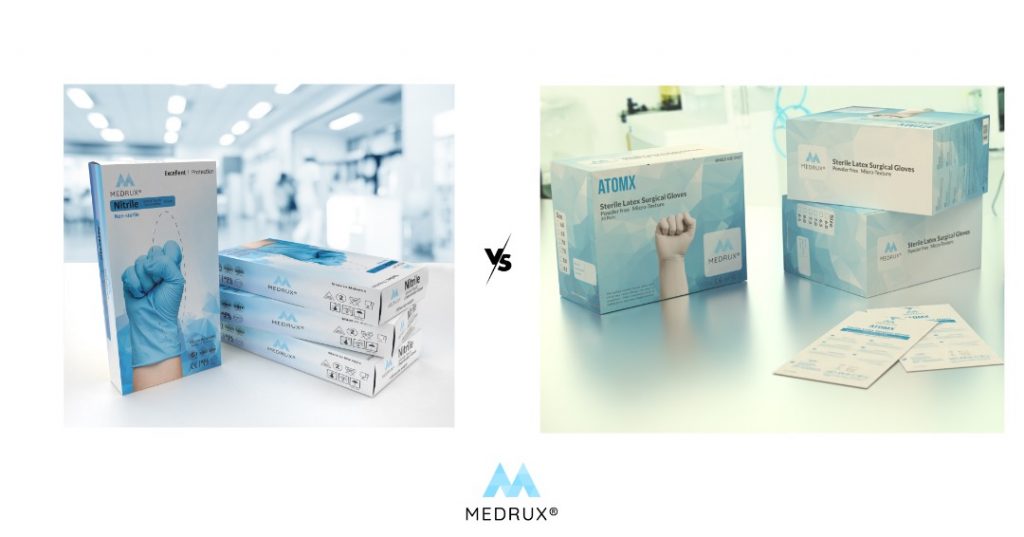
Medical gloves are mainly of two types:
- Examination &
- Surgical
Compared to exam gloves, surgical gloves have exact sizing and offer excellent sensitivity. They are of the highest standard. Examination gloves are available as sterile and non-sterile, but surgical gloves are usually sterile.
Nitrile medical gloves are an excellent choice in the healthcare sector. They can protect against all bodily fluids, pathogens in the blood and moreover are puncture resistant.
Have you noticed that most often, the medical gloves are blue in color?
This is because traditionally, nitrile gloves come in blue color. This is to differentiate them from latex gloves. Latex gloves can cause severe allergic reactions in some people, and the blue color lets them know that the gloves are safe.
Moreover, the color also helps people avoid cross-contamination in specific environments such as labs or exam rooms.
Industrial gloves
Industrial gloves offer protection against heat, sharp objects, chemicals, harmful environment, etc., and keep the hands safe.
They are used mainly in manufacturing, assembly plants, chemical plants, and medical institutions where you need protection from heat, corrosive agents, chemicals, and any other harmful object.
In industrial gloves, nitrile chemical resistant gloves are ideal for most tasks, including against chemicals, in the foodservice sector, Auto mechanics industry use at home for various tasks, and much more.
How to choose the best gloves for industrial and medical purposes?
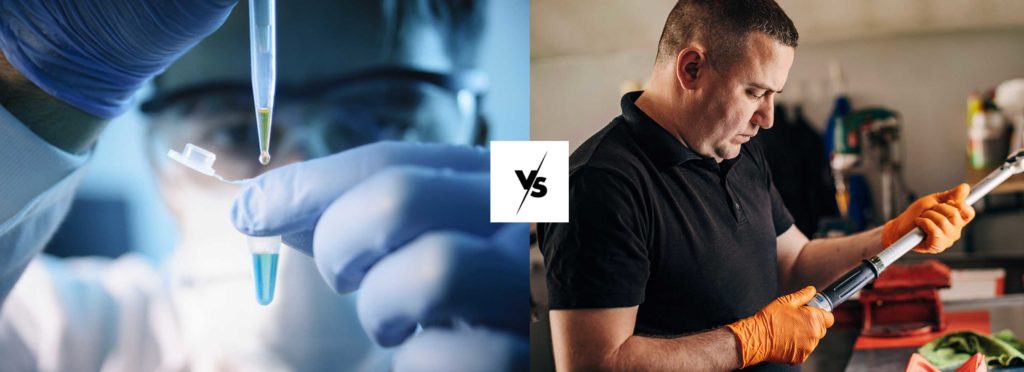
The most important factor for choosing the right gloves for medical and industrial uses is the material.
We have seen the various types of materials and how they can be used.
However, apart from the material, there are certain other conditions, which are equally important.
-
Powdered or powderless gloves
Did you know that most of the powderless gloves are made with powder?
The powder helps in releasing the gloves from their molds.
After they are taken off the molds, the gloves are rinsed and dried to remove excess powder residue.
Powdered gloves are not as expensive as powderless gloves because they don’t have to be washed and dried.
They contain more of the manufacturing chemicals used in the production. These chemicals are then released in the air along with powder when you use them.
-
Length and thickness
Thicker gloves provide better protection against chemicals, but thinner gloves offer better flexibility and touch sensitivity.
You must choose the thickness of the gloves depending on the type of protection you need.
Glove manufacturers state that by doubling the thickness of a glove, you can increase the breakthrough time by 4 times.
The length of gloves is also essential and depends on the type of task you will undertake.
A few splashes can be handled with regular gloves, but immersion in chemicals will require 14 inches or longer gloves.
For tasks such as deep tank cleaning, you may need gloves as long as 30 inches or more.
-
Lining and finishes
Gloves come in different types of finishes. Textured finishes give the gloves a better grip. G
loves also have different types of linings. Cotton linings are great for sweat absorption.
Knit linings can also absorb perspiration and additionally offer some protection against cold.
-
Consider the manufacturing process
You must give due consideration to the process of glove manufacturing.
Sometimes the curing agents used in the process of making the gloves and other components can cause irritation.
This is more the case with cheaper gloves which are made with cheaper quality raw materials.
Select a manufacturer (such as MEDRUX) who can offer clean products.
Gloves that have been rinsed thoroughly and all irritants removed from them are better for your hands.
-
Innovations
Technological advances mean that the gloves are getting better and more comfortable. Now, you can get gloves that will not irritate your skin but actually heal it. Some of these new additions are:
- Aloe: Aloe is a well-known moisturizer with healing and soothing properties. It is possible to get gloves that have a thin layer of aloe gel on the inside. During the manufacturing process, the gel is applied and dried thoroughly. When the user wears the glove, the aloe is rehydrated and keeps the hands moisturized.
- 5.5 pH technology: it is important to maintain the right pH level for the skin to heal. If the skin pH is too high, it is difficult for the skin to fight against any infections. If the pH is too low, then the skin appears dull, dry, and aged. Some gloves are designed to keep the skin pH at 5.5. This promotes good hand health and reduces irritation. These gloves are more soothing and can be worn for longer durations.
What is Hazard assessment?
A Hazard Assessment is generally carried out by someone familiar with the task to be performed.
The assessment starts with knowing exactly which chemicals and combinations of chemicals will be used for the job.
Next, the toxic properties of the chemical are determined according to the Safety Data Sheets or SDS.
It lays down recommendations and regulations for what type of PPE is necessary to protect the user.
Along with the job requirements, the degree of dexterity required for each task must also be considered.
Thinner gloves are more suited for tasks that need motor skills, such as lab work.
The length of exposure to the chemical is another part of hazard assessment. Is it going to be continual contact with the chemical or just intermittent contact?
After considering all these points, the person can do a proper hazard assessment.
Are thin surgical gloves able to offer chemical resistance?
Thin surgical gloves offer excellent tactile sensitivity and dexterity, but unfortunately, they are not resistant to chemicals.
The surgical gloves are pretty thin, and the material stretches over the wearer’s hand to allow for better sensitivity.
This stretching leaves big spaces in the glove’s material at the molecular level. These spaces allow chemicals to permeate quite quickly.
This means that you can wear these gloves for a limited amount of time. Some nitrile surgical gloves can offer some protection from chemicals.
These do not give protection against complete immersion and prolonged contact with the chemicals.
The thin surgical gloves are best used for specific tasks and not as protection against chemicals.
Is it possible to reuse gloves?
Many people think that once you decontaminate the gloves, it is alright to reuse them.
Yes, it is possible but not highly practical.
The process of decontamination would cost more than getting new gloves.
Glove manufacturers also do not recommend this.
It is best to remember that gloves are an item that needs timely replacement, especially after chemical exposure.
Conclusion
Thanks to the technical advances, now it is possible to get the perfect gloves. Users can get the right size, thickness, length, material, texture, etc., in a glove.
The combination of comfort and flexibility, along with high levels of protection, is possible now.
In the medical and industrial sectors, having the best acid-resistant gloves is important and necessary.
For people to carry out their jobs in the best way possible, a high level of protection is a must.
With so many options available nowadays, it is more important to understand your requirements. This is the only way you can make the best choice for any specific task.
Equally important is to understand what goes into making any glove. This will also help you in making the right choice.
Remember that choosing the right gloves that protect the workers and offering comfort and dexterity will keep them safe and happy.
Only safe and happy workers can be genuinely productive.
